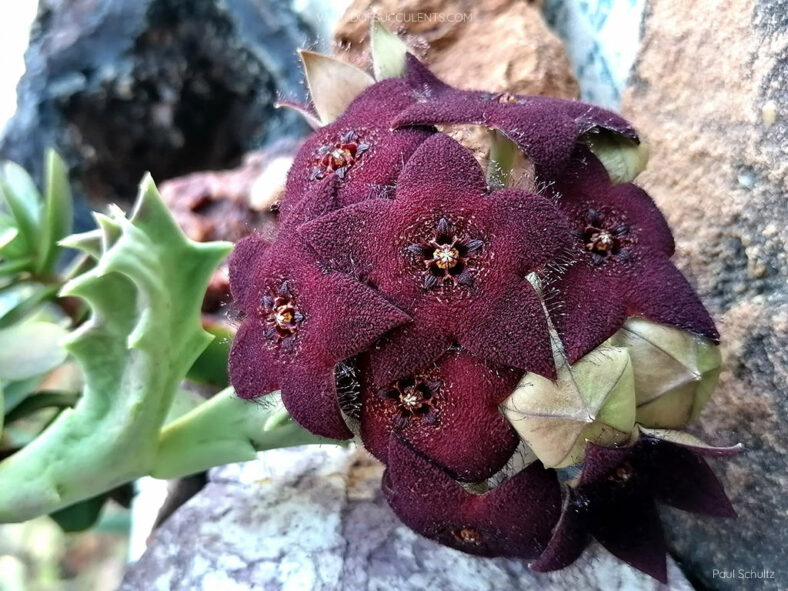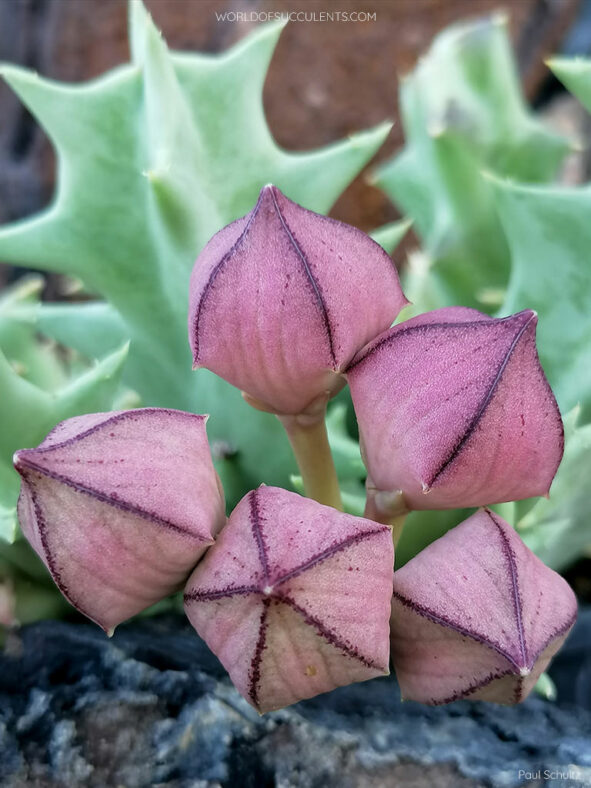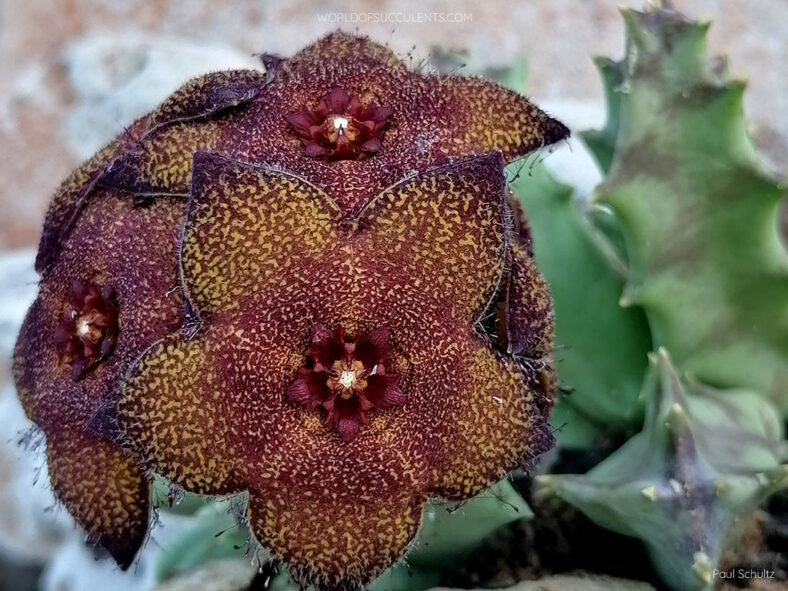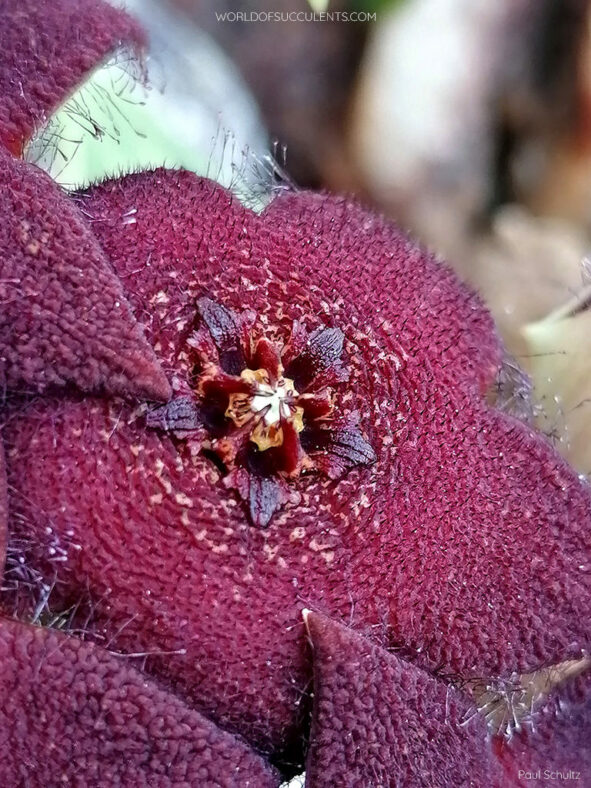Even when not in bloom, Orbea melanantha forms an attractive ground cover, making it an excellent addition to rockeries or succulent gardens. It can also thrive as a potted plant if given enough room to spread out.
Scientific Name
Orbea melanantha (Schltr) Bruyns
Synonym(s)
Caralluma melanantha, Ceropegia melanantha, Orbeopsis melanantha, Stapelia melanantha
Scientific Classification
Family: Apocynaceae
Subfamily: Asclepiadoideae
Tribe: Ceropegieae
Subtribe: Stapeliinae
Genus: Orbea
Etymology
The specific epithet "melanantha (pronounced mel-an-ANTH-uh)" means "with black flowers" and refers to the often almost black flowers of this species.
Origin
Orbea melanantha is native to Mozambique, South Africa (Limpopo, Mpumalanga, Gauteng, and Free State), and Zimbabwe. It grows on stony ground near and under shrubs at elevations above 3,280 feet (1,000 m).
Description
Orbea melanantha is a mat-forming succulent with decumbent stems with prominent deltoid tubercles joined into four thick, continuous, wing-like angles along the stem. The stout stems are pale green mottled with red-brown. They can grow up to 4 inches (10 cm) long and 1.6 inches (4 cm) thick, excluding teeth. The tubercles can measure 6 inches (1.5 cm) long and taper into a stout tooth that gradually becomes hardened and covered with a yellowish corky layer.
The short-lived flowers appear in clusters of 3 to 13, simultaneously opening from a thick, usually arising around the middle of the stem in summer and fall. The flower stalks can grow up to 0.6 inches (1.5 cm) long. The flowers remain open for only a day or two and emit a frightful smell of excrement. The corolla can reach up to 2.6 inches (6.5 cm) in diameter and is almost completely flat when fully open. Inside, it is deep red-brown to nearly black, sometimes finely spotted with yellow, densely wrinkled, finely hairy, and has club-shaped purple cilia, up to 0.2 inches (0.5 cm) long, along the margins of the lobes. Outside, it is smooth and pale cream suffused with brown. The corona is red-brown to purple-black and can reach up to 0.15 inches (0.3 cm) in height and up to 0.35 inches (0.9 cm) in width.

How to Grow and Care for Orbea melanantha
Light: Orbea melanantha thrives in full sun or partial shade during the hottest summer days. Too much sun causes the stems to develop a protective pigmentation or get sunburned. Not enough light leads to weak, thin stems and fewer flowers. Indoors, place the plant near a sunny window in your home.
Soil: The right soil is crucial to growing a healthy plant. Use commercial soil for succulents, or prepare your own mix with 50 to 70 % mineral grit, such as coarse sand, pumice, or perlite.
Temperature: This plant thrives in warm outdoor environments but does not like winter cold. During its winter dormancy, it should remain moderately dry and warm. Orbea melanantha grows best in USDA Plant Hardiness Zones 11a to 11b, with average minimum winter temperatures ranging from 40 to 50 °F (4.4 to 10 °C).
Watering: It has typical watering needs for a succulent. During the growing season, water your plant thoroughly and allow the soil to dry before watering again. In winter, the plant goes dormant and needs almost no water, about once a month.
Fertilizing: To keep it thriving, fertilizing during the growing season is a good idea. Feed with water-soluble fertilizer diluted to half the recommended strength.
Repotting: Orbea melanantha will benefit from fresh potting soil every 2 or 3 years. Repot it in spring, just before the growing season starts. Pick a container with drainage holes.
Propagation: The best way to propagate this succulent is through stem cuttings. However, it is also easy to grow from seeds. To ensure good rooting, take cuttings during the growing season and sow the seeds in spring.
Learn more at How to Grow and Care for Stapelia.
Toxicity of Orbea melanantha
Orbea melanantha has no toxic effects reported. It is safe around pets and humans.
Links
- Back to genus Orbea
- Succupedia: Browse succulents by Scientific Name, Common Name, Genus, Family, USDA Hardiness Zone, Origin, or cacti by Genus
Photo Gallery
Click on a photo to see a larger version.


